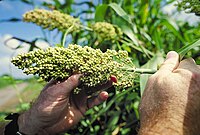
Photo from wikipedia
Modifying lignin content and composition of cell walls are key targets for bioenergy feedstock improvement for a range of renewable chemical applications. Sorghum (Sorghum bicolor) is a drought-tolerant C4 grass… Click to show full abstract
Modifying lignin content and composition of cell walls are key targets for bioenergy feedstock improvement for a range of renewable chemical applications. Sorghum (Sorghum bicolor) is a drought-tolerant C4 grass being developed as a dedicated bioenergy feedstock. The monolignol biosynthetic pathway produces the hydroxycinnamic subunits of lignin, a major target to increase the energy content of sorghum biomass for thermal bioenergy conversion processes. SbMyb60 is a transcription factor linked to the activation of the monolignol biosynthetic pathway and caffeoyl CoA O-methyltransferase (SbCCoAOMT) is a S-adenosyl methionine (SAM)–dependent O-methyltransferase responsible for the methylation of caffeoyl-CoA to generate feruloyl-CoA in this pathway. Overexpression of each gene resulted in increased energy content of biomass and increased levels of several aromatic compounds in previous greenhouse experiments. To assess how SbMyb60 and SbCCoAOMT overexpression lines performed under field conditions, these lines were planted in field trials over two growing seasons, 2017 and 2018, and the effects on lignin composition and content as well as agronomic traits were assessed. Field-grown plants of SbMyb60 and SbCCoAOMT overexpression lines had increased total energy and phenolic compounds. Furthermore, two SbMyb60 transgenic events, SbMyb-10a and SbMyb-15a, with decreased stover yield and seed set were combined with three sorghum lines, N32, N4692, and Tx3118, to investigate whether yield reduction could be rescued. Hybrids improved yield of SbMyb60-15a; however, hybrids were unable to improve performance for SbMyb60-10a. Overall, these results demonstrated that field-grown sorghum overexpressing SbMyb60 or SbCCoAOMT can have biomass with increased phenolic compounds and total energy.
Journal Title: Bioenergy Research
Year Published: 2020
Link to full text (if available)
Share on Social Media: Sign Up to like & get
recommendations!